ArboNET: National surveillance system for arboviral diseases in the ...
ArboNET: National surveillance system for arboviral diseases in the ...
ArboNET: National surveillance system for arboviral diseases in the ...
You also want an ePaper? Increase the reach of your titles
YUMPU automatically turns print PDFs into web optimized ePapers that Google loves.
<strong>ArboNET</strong>: <strong>National</strong> <strong>surveillance</strong> <strong>system</strong><strong>for</strong> <strong>arboviral</strong> <strong>diseases</strong> <strong>in</strong> <strong>the</strong> United StatesMarc Fischer, MD, MPHArboviral Diseases BranchCenters <strong>for</strong> Disease Control and PreventionFort Coll<strong>in</strong>s, ColoradoJune 25, 2008
<strong>ArboNET</strong> background• <strong>National</strong> electronic <strong>surveillance</strong> <strong>system</strong> <strong>for</strong><strong>arboviral</strong> <strong>diseases</strong> <strong>in</strong> <strong>the</strong> U.S.• Developed <strong>in</strong> 2000 <strong>in</strong> response to <strong>the</strong> detectionof WNV <strong>in</strong> <strong>the</strong> U.S. <strong>in</strong> 1999• Non-WNV <strong>arboviral</strong> <strong>diseases</strong> added to <strong>the</strong><strong>system</strong> <strong>in</strong> 2003
<strong>ArboNET</strong> objectives• Monitor <strong>the</strong> epidemiology, <strong>in</strong>cidence, andgeographic spread of WNV and o<strong>the</strong>r arboviruses• Provide timely <strong>in</strong><strong>for</strong>mation regard<strong>in</strong>g <strong>arboviral</strong><strong>diseases</strong> to public health officials, governmentleaders, researchers, cl<strong>in</strong>icians, and <strong>the</strong> public• Support prevention and control ef<strong>for</strong>ts, andstimulate research on <strong>arboviral</strong> <strong>diseases</strong>• Evaluate fund<strong>in</strong>g needs
Arboviruses listed <strong>in</strong> <strong>ArboNET</strong>• Cache Valley (CV)• Cali<strong>for</strong>nia serogroup (CAL) [unspecified]• Chikungunya (CHIK)*• Colorado tick fever (CTF)*• Dengue (DEN)• Eastern equ<strong>in</strong>e encephalitis (EEE)• Jamestown Canyon (JC)• Japanese encephalitis (JE)• LaCrosse (LAC)• Powassan (POW)• St Louis encephalitis (SLE)• Venezuelan equ<strong>in</strong>e encephalitis (VEE)• Western equ<strong>in</strong>e encephalitis (WEE)• West Nile (WN)*Added <strong>in</strong> 2008
Scope of <strong>ArboNET</strong> <strong>surveillance</strong>• Human disease cases• Presumptive viremic donors (PVDs)from rout<strong>in</strong>e blood donor screen<strong>in</strong>g• Veter<strong>in</strong>ary• Avian• Sent<strong>in</strong>el chickens• Mosquitoes
Human disease case and PVD data elements• Demographics (age, sex)• County of residence• Date of symptom onset (or date of donation)• Type of arbovirus (WNV, LAC, SLE, EEE, etc.)• Case status (Confirmed, probable, suspect, not a case)• Cl<strong>in</strong>ical syndrome (Encephalitis, men<strong>in</strong>gitis, fever, asymp)• Hospitalized• Outcome (Died/survived)• Blood or organ recipient
New human disease case data <strong>for</strong> 2008• Medical risk factors‣Underly<strong>in</strong>g medical conditions‣Immunosuppressive medications• Laboratory where <strong>arboviral</strong> test<strong>in</strong>g was per<strong>for</strong>med‣Public health laboratory (CDC or state)‣Commercial laboratory
Non-human <strong>surveillance</strong> data elements*• Animal species• State and county• Date of symptom onset or collection• Type of arbovirus (WNV, LAC, SLE, EEE, etc.)*Includes veter<strong>in</strong>ary, dead birds, sent<strong>in</strong>el chickens, and mosquitoes
Data report<strong>in</strong>g and flow• Health care providers, veter<strong>in</strong>arians, and commerciallabs report data to <strong>the</strong>ir state/local health department• State/local health departments receive and enter<strong>surveillance</strong> data <strong>in</strong>to an electronic database• State health departments upload data to CDCdatabase regularly (usually weekly)• CDC analyzes data and dissem<strong>in</strong>ates <strong>in</strong><strong>for</strong>mationregularly (weekly dur<strong>in</strong>g <strong>the</strong> WNV season)
Dissem<strong>in</strong>ation of <strong>ArboNET</strong> data• Weekly updates posted onl<strong>in</strong>e and EpiX• Weekly updates of US Geologic Service (USGS)maps with number of cases by state and county• Monthly MMWR updates from July-November• Annual MMWR summary• Peer-reviewed journal articles
<strong>ArboNET</strong> data provided <strong>in</strong> weekly updates• Human neuro<strong>in</strong>vasive and non-neuro<strong>in</strong>vasivedisease cases by state• Human deaths by state• Human case demographic data (age, sex)• Viremic blood donors by state• Veter<strong>in</strong>ary, avian, sent<strong>in</strong>el, and mosquitocases/pools• Comparisons to previous year at same week
www.cdc.gov/ncidod/dvbid/westnile/<strong>in</strong>dex.htm
EpiX post<strong>in</strong>g of <strong>ArboNET</strong> data
http://diseasemaps.usgs.gov/
USGS national map of <strong>ArboNET</strong> data
USGS state map of <strong>ArboNET</strong> data
Human disease cases• Arboviral <strong>diseases</strong> are nationally notifiableconditions <strong>in</strong> <strong>the</strong> U.S.• Data reported to <strong>ArboNET</strong> from all states and threeo<strong>the</strong>r districts (i.e., DC, NYC, Puerto Rico)• Human disease cases are classified and reportedaccord<strong>in</strong>g to standardized, published case def<strong>in</strong>itions‣ Neuro<strong>in</strong>vasive (i.e., encephalitis, men<strong>in</strong>gitis, AFP)‣ Non-neuro<strong>in</strong>vasive disease (e.g., fever, o<strong>the</strong>r)
Neuro<strong>in</strong>vasive and non-neuro<strong>in</strong>vasive disease• Neuro<strong>in</strong>vasive disease‣ Test<strong>in</strong>g and report<strong>in</strong>g is thought to be fairly completeand representative‣ Data used to calculate rates, project total number ofcases and <strong>in</strong>fections based on serosurvey data, andcompare trends over time and place• Non-neuro<strong>in</strong>vasive disease‣ Test<strong>in</strong>g and report<strong>in</strong>g varies by year and jurisdiction‣ Data used to identify human disease <strong>in</strong> areas where noneuro<strong>in</strong>vasive cases reported
Presumptive viremic donors (PVDs)• Rout<strong>in</strong>e screen<strong>in</strong>g of U.S. blood supply us<strong>in</strong>gnucleic acid amplification tests (NAAT) s<strong>in</strong>ce 2003• Blood services agencies report donors who screenpositive to <strong>the</strong> local/state health department• PVDs followed up by <strong>the</strong> blood services agencywith additional tests (PCR, IgM) to verify <strong>in</strong>fection• Some PVDs go on to develop symptoms afterdonation and are <strong>the</strong>n reported as a case
Human WNV disease cases reportedto <strong>ArboNET</strong>, 2007 (N=3,630)n (%)WNV neuro<strong>in</strong>vasive disease* 1,227 (34)WNV fever2,350(65)Not specified 53 (1)*Encephalitis (n=765), men<strong>in</strong>gitis (n=452), AFP (n=63); 53 patientshad both AFP and concurrent encephalitis/men<strong>in</strong>gitis
WNV human neuro<strong>in</strong>vasive disease<strong>in</strong>cidence <strong>in</strong> <strong>the</strong> U.S., 2007
WNV presumptive viremic blood donorsreported to <strong>ArboNET</strong>, 2007 (N=352)n (%)Asymptomatic 281 (80)WNV neuro<strong>in</strong>vasive disease*5(1)WNV fever* 66 (19)*These PVDs were counted as human disease cases
WNV viremic blood donors<strong>in</strong> <strong>the</strong> U.S., 2007
Veter<strong>in</strong>ary cases/ deaths• Not nationally notifiable‣ Collection and report<strong>in</strong>g varies by jurisdiction‣ In 2007, veter<strong>in</strong>ary data reported from 36 states/districts• Veter<strong>in</strong>arians, animal control, wildlife managementofficers, and public health labs report cases to states• Primarily horses but can <strong>in</strong>clude o<strong>the</strong>r non-humanmammals (e.g., dogs, squirrels, cats, raccoons)
WNV-positive non-human mammalsreported to <strong>ArboNET</strong>, 2007 (N=507)n (%)Equ<strong>in</strong>e 471 (93)Squirrel27(5)Can<strong>in</strong>e 5 (1)O<strong>the</strong>r species4(1)
USGS map of <strong>ArboNET</strong> veter<strong>in</strong>ary data
Avian (dead birds)• Not nationally notifiable‣ Collection and report<strong>in</strong>g varies by jurisdiction‣ In 2007, avian data reported from 37 states/districts• Citizens, animal control, wildlife managementofficers collect and submit dead birds to lab• Test<strong>in</strong>g per<strong>for</strong>med varies by jurisdiction‣ None, corvids only, all birds‣ Limited number, until human case detected, all birds‣ WNV only, o<strong>the</strong>r arboviruses
WNV-positive bird species reportedto <strong>ArboNET</strong>, 2007 (N=1,883)n (%)American crow 991 (53)Blue jay 273 (14)Western scrub – jay 239 (13)Yellow-billed magpie 110 (6)House f<strong>in</strong>ch 81 (4)House sparrow 58 (3)Red tailed hawk 30 (2)American rob<strong>in</strong> 29 (2)Common raven 25 (1)O<strong>the</strong>r species 47 (2)
USGS map of <strong>ArboNET</strong> avian data
Sent<strong>in</strong>el chickens• Not nationally notifiable‣ Collection and report<strong>in</strong>g varies by jurisdiction‣ In 2007, sent<strong>in</strong>el chickens reported from 14 states/districts• Health depts place non-immune chickens <strong>in</strong> high riskareas to screen <strong>for</strong> <strong>arboviral</strong> seroconversion• Test<strong>in</strong>g per<strong>for</strong>med varies by jurisdiction‣ WNV only, o<strong>the</strong>r arboviruses‣ Screen at variable <strong>in</strong>tervals (weekly to monthly)
Mosquitoes• Not nationally notifiable‣ Collection and report<strong>in</strong>g varies by jurisdiction‣ In 2007, mosquito data reported from 40 states/districts• Health depts or vectors control agencies placetraps to collect mosquito pools and evaluate <strong>the</strong>pools <strong>for</strong> species and <strong>arboviral</strong> <strong>in</strong>fection• Test<strong>in</strong>g per<strong>for</strong>med varies by jurisdiction‣ Number of traps and locations‣ PCR, culture‣ WNV only, o<strong>the</strong>r arboviruses
WNV-positive mosquito pools by speciesreported to <strong>ArboNET</strong>, 2007 (N=8,082)n (%)Culex spp., not specified 1,642 (20)Cx. tarsalis 1,566 (19)Cx. pipiens 1,555 (19)Cx. pipiens/restuans 1,505 (19)Cx. qu<strong>in</strong>qefasciatus 1,081 (13)Cx. pipiens complex 299 (4)Cx. restuans 240 (3)Cx. nigripalpus 68 (1)Aedes albopictus 49 (1)O<strong>the</strong>r species 77 (1)
USGS map of <strong>ArboNET</strong> mosquito data
<strong>ArboNET</strong> strengths (1)• Comprehensive <strong>arboviral</strong> disease <strong>surveillance</strong> <strong>system</strong> thatcollects human, animal, and ecologic data• Provides national human <strong>arboviral</strong> disease and PVD dataus<strong>in</strong>g standardized case def<strong>in</strong>itions• Provides <strong>in</strong>cidence, and geographic and temporal trends <strong>for</strong>neuro<strong>in</strong>vasive <strong>arboviral</strong> <strong>diseases</strong>• Human, animal, and ecologic data gives broader picture ofarbovirus transmission activity and migration
<strong>ArboNET</strong> strengths (2)• Animal and ecologic data help def<strong>in</strong>e arbovirus animalreservoirs and vectors <strong>in</strong> <strong>the</strong> U.S. by region• Electronic <strong>system</strong> with potential <strong>for</strong> real time report<strong>in</strong>g• Timely, comprehensive, and readily available data feedback• Strong collaborations between CDC, state/local healthdepartments, blood services agencies, and USGS
<strong>ArboNET</strong> limitations• Passive <strong>surveillance</strong> <strong>system</strong>• M<strong>in</strong>imal cl<strong>in</strong>ical and laboratory data <strong>for</strong> human disease cases• Cannot confirm that patients meet <strong>the</strong> case def<strong>in</strong>ition• Can be long delays between case occurrence and report<strong>in</strong>g• Human fever cases, animal data, and ecologic data arereported variably and likely not representative (i.e., cl<strong>in</strong>ically,geographically, or temporally)• Different report<strong>in</strong>g <strong>system</strong> than is used <strong>for</strong> most o<strong>the</strong>rnationally notifiable <strong>diseases</strong>• Requires significant personnel, time, and money
<strong>ArboNET</strong> questions• Do human fever case data provide a more complete pictureof where human disease is occurr<strong>in</strong>g?• Do animal and ecologic data help predict human diseaseand provide timely warn<strong>in</strong>g <strong>for</strong> local outbreaks?• Can <strong>the</strong> data be used to develop predictive models <strong>for</strong><strong>arboviral</strong> disease risk factors or trends?• Can <strong>the</strong> data be used to help per<strong>for</strong>m cl<strong>in</strong>ical trials or postmarket<strong>in</strong>g<strong>surveillance</strong> <strong>for</strong> a WNV vacc<strong>in</strong>e?• Can <strong>the</strong> <strong>system</strong> help detect <strong>the</strong> <strong>in</strong>troduction or emergenceof a new domestic arbovirus (e.g., dengue, chikungunya,Japanese encephalitis, Zika)?
Acknowledgments• Jennifer Lehman• Nicole L<strong>in</strong>dsey• Anne Griggs• Mark Duffy• Er<strong>in</strong> Staples• Ned Hayes• Nick Komar• Emily Ziel<strong>in</strong>ski-Gutierrez• Roger Nasci• Lyle Petersen• Peggy Coll<strong>in</strong>s and <strong>the</strong> <strong>ArboNET</strong> technical staff• State/local health dept <strong>ArboNET</strong> <strong>surveillance</strong> coord<strong>in</strong>ators


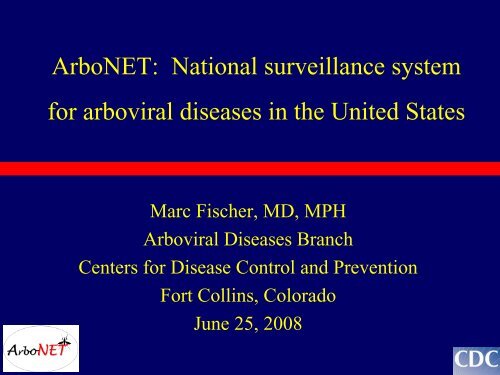
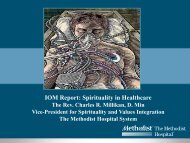


![Barry Davis Presentation.ppt [Read-Only] - Institute of Medicine](https://img.yumpu.com/31160415/1/190x146/barry-davis-presentationppt-read-only-institute-of-medicine.jpg?quality=85)
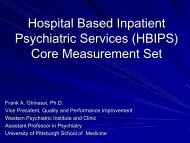
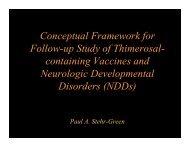
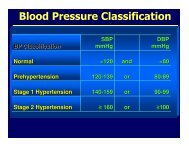
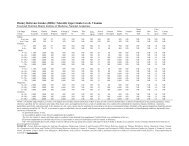

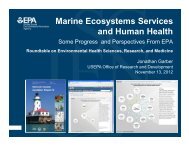

![Diekema.ppt [Compatibility Mode] - Institute of Medicine](https://img.yumpu.com/5085552/1/190x146/diekemappt-compatibility-mode-institute-of-medicine.jpg?quality=85)
